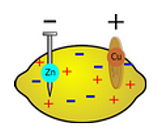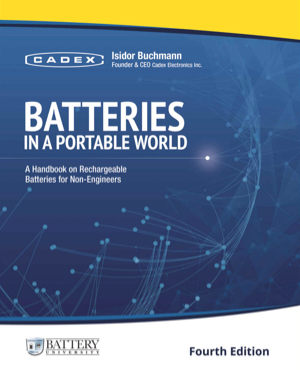BU-104: Conociendo la Batería (Español)
Nature offers many ways to produce power. Most result through combustion, mechanical movement and photosynthesis, as in a solar cell. Electrical energy generation of the battery develops by an electrochemical reaction between two metals of different affinities. When exposed to acids, a voltage develops between the metals as part of ion transfer; closing the circuit induces a current. In 1800, inventor Alessandro Volta discovered that the voltage potential became stronger the farther apart the affinity numbers moved.
The simplest manifestation of a battery is a lemon. Driving a zinc-plated nail and a copper coin into a lemon creates a voltage, but this quasi battery does not deliver much power. The current delivery system is weak and any electrical load causes the voltage to collapse. The energy does not come from the lemon itself but from the chemical change in dissolving zinc into the acid or lemon juice. Figure 1 illustrates the lemon battery.
 | The experiment is often used for educational purposes. The electrodes are zinc in the form of a galvanized nail and copper in a coin. The lemon juice acts as electrolyte to induce a chemical reaction. Standard potential of zinc = –0.76 Standard potential of copper = 0.34 Cell potential with conducting path = 1.10V |
Elements with the greatest negative electrode potential serve as cathodes; those with the highest positive potential assist as anodes. The difference between the electrodes provides the terminal voltage. For a rechargeable battery to be practical, the chemical reactions between the elements must be reversible. To complicate matters further, chemical reactions between compounds cannot consume the active chemicals, and this limits the pool of suitable electrodes.
Multiplying the voltage by the current provides power. Power is measured in watts in honor of James Watt, the 18th-century developer of the steam engine. The amount of energy a battery can store is expressed in watt-hours (Wh).
All energy sources have limitations, and power must be harnessed carefully so as not to cause an overload. An analogy is a bicycle rider (Figure 2) who chooses the best gear ratio to transfer power into propulsion. On a flat road, a high gear provides high speed with moderate pedal torque simulating high voltage. Climbing a hill, the pedal torque increases while the speed decreases. This, in our analogy, results in a lower voltage and higher current. The pedal force the rider exerts relates to torque in newton meter (Nm); the endurance before exhaustion defines energy in watt-hours (Wh).

Energy is the product of power and time, measured in watt-hours (Wh); power is the flow of energy at any one time, measured in watts.
A battery is rated in ampere-hours (Ah). This specifies how much charge a pack can hold. Like fluid in a container, the energy can be dispensed slowly over a long period of time or rapidly in a short time. The amount of liquid a container holds is analogous to the energy in a battery; how quickly the liquid is dispensed is analogous to power.
The physical dimensions are specified by volume in liters (l) and kilograms (kg). Adding dimension and weight provides specific energy in Wh/kg, power density in W/l and specific power in W/kg. Most batteries are rated in Wh/kg, revealing how much energy a given weight can generate. Wh/l denotes watt-hours per liter. (See BU-105: Battery Definition)
Batteries are custom-fit for a specific use, and manufacturers are well in tune with customer needs. Mobile phone and EV markets are examples of clever adaptations at opposite extremes. While batteries for consumer products emphasize small size, high specific energy and low cost, industrial batteries strive for reliable performance and long life. Safety in all applications is of utmost importance.

Comments
Looking for comments from the previous website?
Comments from the previous website are not compatible with our new commenting system but we have preserved them so our users can still reference and make use the information in them.
